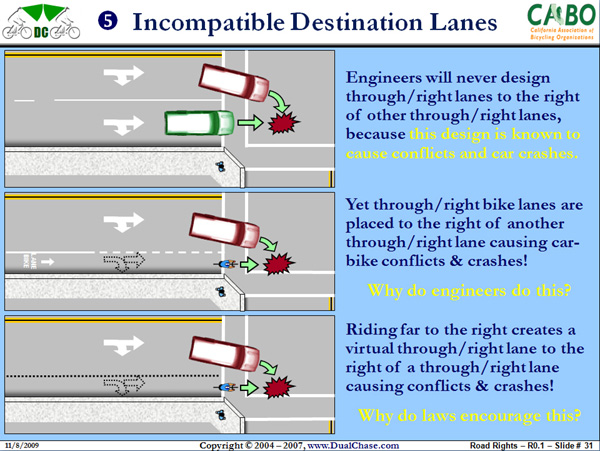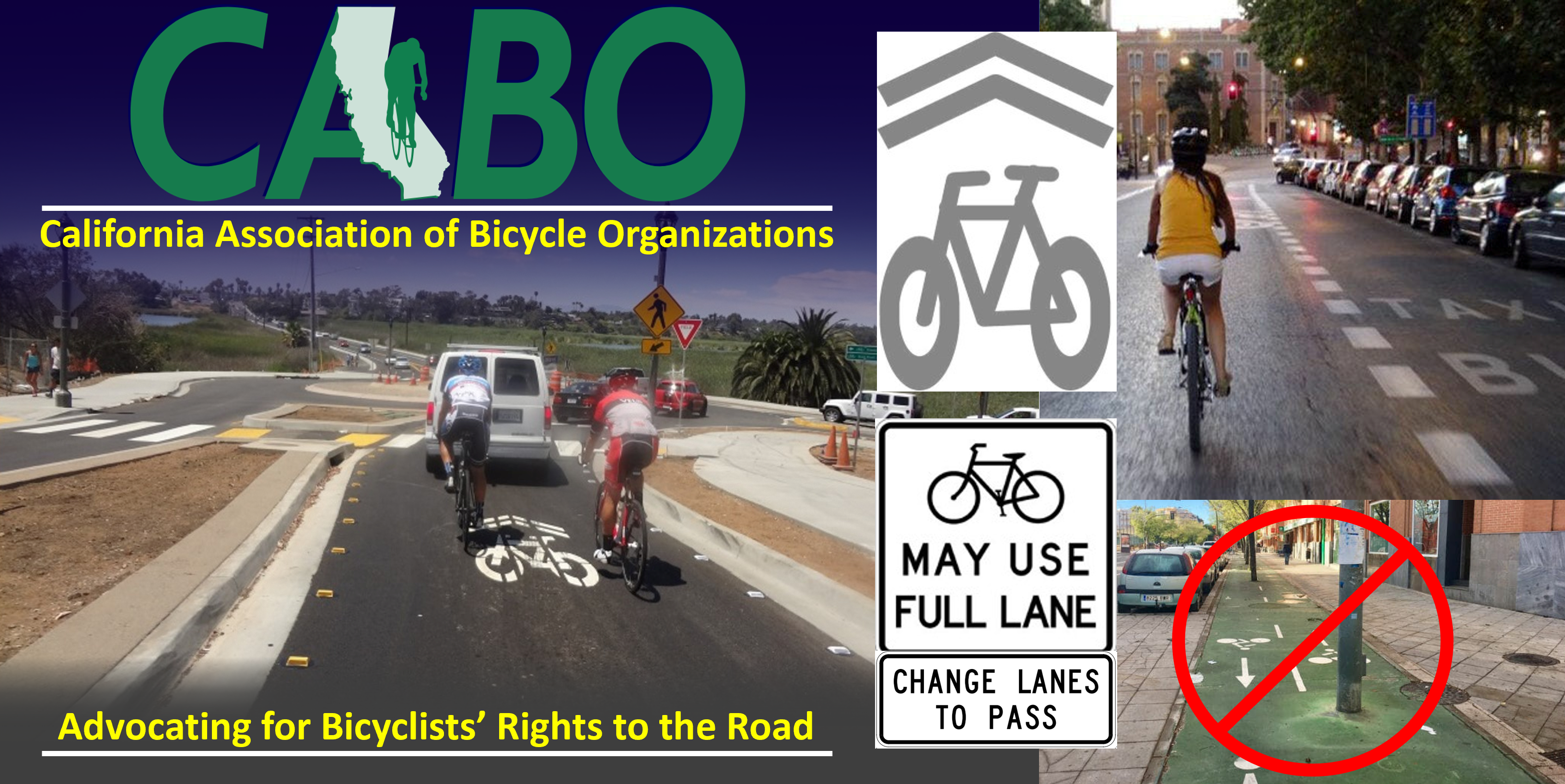SB910 was amended in the Assembly on June 22. With minor exceptions, the amended SB910 language reflects CABO’s suggested wording for CVC 21750.1. Therefore, CABO has now changed its position on SB910 from “oppose” to “support.” Many thanks to Senator Lowenthal for adequately addressing our concerns.
CABO Brings SB910 Concerns to Lowenthal’s Staff
CABO continues to take an “oppose until amended” position on “three-foot passing law” SB910. CABO representatives recently met with Senator Lowenthal’s staff to address CABO’s concerns.
Although we listed several points in a previous blog post, a key concern was the exemption from the three-foot requirement when the motorist-cyclist speed differential is 15 mph or less. While this was intended to facilitate overtaking in slow or stopped traffic, this could have unintended consequences -such as giving a legal defense for a 55 mph motorist who passes within inches of a 40 mph cyclist traveling downhill.
CABO representatives suggested the following wording to address the 15 mph differential and other concerns: Continue reading
CABO Opposes 3-Foot Passing Bill SB910
Regrettably, CABO opposes SB910 for the following reasons (most of which are mentioned in the bill analysis):
1. The law already provides that motorists must pass bicyclists at a safe distance without interfering with their safe operation.
2. We don’t believe that three feet is measurable or enforceable in practice.
3. Emphasizing three feet as the passing distance may encourage some drivers to pass too closely when greater clearance is needed.
4. A 15-mph speed differential also can’t be measured or enforced, and is not always appropriate.
5. By amending CVC 21750 to remove references to bicycles and replacing it with CVC 21750.1, which always requires passing on the left, the bill apparently makes it unlawful to pass a bicyclist on the right, even if the bicyclist is turning left.
6. The language of proposed CVC 21750.1 is ambiguous:
“The driver of a motor vehicle overtaking a bicycle proceeding in the same direction shall pass to the left at a safe distance, at a minimum clearance of three feet or at a speed not exceeding 15 miles per hour faster than the speed of the bicycle, without interfering with the safe operation of the overtaken bicycle.”
“At a safe distance,” “at a minimum clearance of three feet,” or “at a speed not exceeding 15 miles per hour faster than the speed of the bicycle” can be read as a series of three items any one of which is sufficient. It’s also unclear whether “without interfering with the safe operation of the overtaken bicycle” modifies all of these, or only the last.
7. We support the concept of permitting motorists to cross double yellow lines to pass bicyclists. However, “substandard width lane” is undefined, and the condition given, when “it is safe to do so,” is too vague and allows too much latitude for driver misjudgment.
(June 24 update: CABO Now SUPPORTS 3-Foot Passing Bill SB910)
CABO Comments on Santa Ana River Trail
Below are comments from the California Association of Bicycling Organizations (CABO) on the RRTAC July 19 agenda items relating to the Santa Ana River Trail (SART):
1. First and foremost, we applaud the county’s efforts in reaching out to and working with the cycling community to come up with a SART detour well in advance of the widening of the 91 freeway. Furthermore, we appreciate the county’s commitment to come with a long term solution that will most likely be more attractive than the original concept of a bikeway adjacent to the freeway.
2. When cyclist access to State Route 91 was severed due to conversion to a freeway in the 1970s, the section of the SART between Gypsum Canyon and Green River was constructed to provide an alternate transportational route for cyclists in accordance with Streets and Highways Code Section 888. Continue reading
Argument Against an Idaho Style “Stop as Yield” Law for Bicyclists
There has been talk of legislation being introduced in California to emulate Idaho law, which allows stop signs and/or red lights to be treated as yields by bicyclists. This was posted by David Takemoto-Weerts on January 29 to the “Handlebar” listserve for the Davis Bicycles advocacy group.
At the risk of becoming a pariah among local cycling advocates, I have to respectfully disagree with efforts to support the enactment of the “Idaho law” in California. And let me preface my comments by explaining that I am a daily cyclist (for over 40 years) who always stops at stop signs and always waits for the green light. Continue reading
Ask the traffic engineer: How are speed limits set?
Most people think that motorists base their speeds on the speed limit. But while that may be true on freeways and other high speed highways, it’s not true on lower speed roads and streets. On lower speed roads and streets, motorists base their speeds not on the speed limit but on how the road feels.
If you’re typical, that doesn’t feel right to you. You may be thinking to yourself, doesn’t everyone pay attention to the speed limit like I do? Continue reading
Report on 1/6/2010 Statewide Bicycling Task Force organizational meeting
On January 6, a bicycling task force was formed during a meeting in State Senator Kehoe’s Sacramento office. That meeting was successful and we now have a working task force in place, thanks to the team of bicycling advocates: representing the League of American Bicyclists, the California Association of Bicycling Organizations and the California Bicycle Coalition: CABO President and CBC Board member Jim Baross, CABO lobbyist James Lombardo, CABO Legislative Liaison Alan Wachtel, and CABO Transportation Engineering Liaison Bob Shanteau.
Below is a report on that meeting, but first a little background on how the meeting came about: Continue reading
Signal Timing Issues
AB1581, which became law in 2008, requires all new or replaced traffic signals to respond to the presence of bicyclists. In addition, a requirement to develop signal timing guidance was also a part of AB1581. Both are incorporated in Policy Directive 09-06 from Caltrans.
The video clip below is of a cyclist making a left turn from a residential collector onto a six lane arterial. Although it’s a bit difficult to see in the video due to the wide angle lens, the cyclist’s position when the light turns green for traffic on the arterial is in the middle of the number two lane. The cyclist reaches the bike lane on the other side at about 12 seconds after receiving the green.
Problems with Bike Lanes Striped Solid to the Intersection
Some of our friends in other states, as well as some local advocates have asked me about why bike lanes shouldn’t be striped solid at intersections. Here’s a picture of just such a facility in Florida, care of our friends at CommuteOrlando.com:
http://commuteorlando.com/wordpress/wp-content/uploads/2008/11/onramp1.jpg

- Bike Lane Striped Solid at Intersection in Florida
Here’s a slide that gives a visual representation of the problems created by this bike lane treatment (and even a wide lane under Far To Right law guidance): http://www.cyclistview.com/uploadedphotos/Incompatible-Destination-Lanes-Draft.jpg
 Problems with Incompatible Destination Lanes
Problems with Incompatible Destination LanesAnd here’s a detailed explanation in terms of Engineering and Planning and the Legal/Operational issues that result: Continue reading
Conviction of motorist for assaulting two cyclists in Mandeville Canyon
The LA Times covered the conviction of an ER doctor who assaulted two cyclists in Mandeville Canyon last year in a case of road rage turned deadly:
http://www.latimes.com/news/local/la-me-cyclist3-2009nov03,0,761131.story
The question has been asked by the press and local advocates, “What can we learn from this incident?”
Last year, shortly after the incident occurred, CABO VP, Brian DeSousa and CABO District 7 Director, Dan Gutierrez, made a quick turnaround video answer to this question in order to help local advocates brief Los Angeles City Council members on improved cyclist/motorist relations.
The key is to improve motorist/cyclist cooperation:
